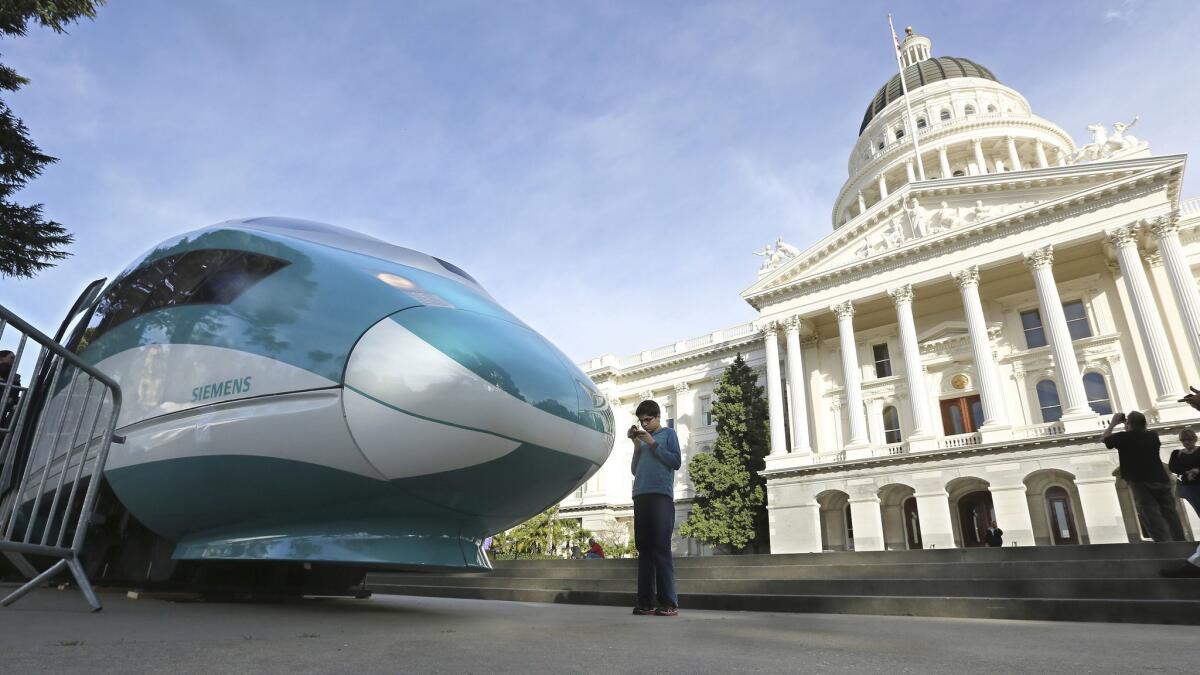Trump’s plan to take back $2.5 billion in California’s high-speed rail funding ‘unprecedented’

- Share via
The Trump administration’s decision to cancel a $929-million grant to California’s troubled high-speed rail project and claw back $2.5 billion in funds already spent has thrust the federal government into uncharted legal territory and poses an existential threat to the state’s largest investment ever.
Never before, experts say, has the federal government attempted to take back such a large sum of money from California, particularly after it was spent under federal supervision.
“I have never seen anything this large,” said Ron Flavin, a San Francisco consultant who advises state agencies and local governments on grants. “I have never seen anything where they said we are going to cancel a grant because of issues in the administrative or bureaucratic process.”
The Federal Railroad Administration this week sent a letter to state officials asserting that the project is out of compliance with major provisions of the grant agreement’s schedule, scope and payment terms.
Trump administration to cancel $929 million in California high-speed rail funding »
California has for years struggled to comply with the grants, which are laid out in lengthy legal documents that have been repeatedly modified over the last decade. At the same time, the project has dealt with funding shortages, contract mismanagement, legal disputes and myriad other complex challenges — issues that were identified in a critical state audit in November.
The nearly $3.5 billion at stake represents about one-fourth of all the funding that the project has on hand today, so its loss could push the state into having to make up for the funding while the dispute is resolved or further curtail the schedule and scope of the Los Angeles-to-San Francisco bullet train.
“This does seem unprecedented,” said Eloise Pasachoff, a law professor specializing in federal grants at the Georgetown University Law Center. “It is common to take money back that grantees misspent. I am unaware of any time when an agency has threatened to terminate a grant because a grantee is not on target to achieve the substantive goals the grant was meant to achieve.”
The aggressive federal action, which experts called extraordinary, follows comments by Gov. Gavin Newsom in hisState of the State speech last week that the project was costing too much, taking too long and lacking a path to completion. He said the state would have the capacity to build a partial line from Merced to Bakersfield in the Central Valley, implying that the larger goals would be kicked down the road.
It was very shortly after Newsom’s comments that President Trump demanded repayment of the grants, calling the project a “green disaster.”
The Federal Railroad Administration’s three-page letter to the state gave “notice of intent” that it would terminate the 2010 grant agreement and said it was also exploring ways to demand repayment of the previous $2.5-billion grant made under the American Recovery and Reinvestment Act.
The letter alleged that California was failing to comply with provisions that required it to spend matching funds and said the state had fallen $100 million short of requirement. It also asserted that the state would miss the 2022 deadline to complete 119 miles of construction in the Central Valley and that the state’s financial reports could not show that it was making reasonable progress with what was being delivered. It also said Newsom’s speech represented a “retreat” from the goals set forth under the grant.
The rail project has struggled to fund all of its work, shifted funds from future work to current work to pay bills, and in some cases fallen behind schedule in paying its contractors. The cost of preparing environmental documents, buying land and moving underground utilities soared beyond original estimates, further stretching budgets.
The structure of the federal letter implies that it is the first step of a formal process. The letter asks the state to provide information that it has fulfilled the terms of the grant and is making reasonable progress on the construction, as well as evidence that Newsom’s speech did not represent a “fundamental change in the purpose of the project.”
The process for canceling the project involves complex administrative law, which probably will require formal hearings, representation by attorneys and a long decision process within the federal government, as well as potential legal challenges in federal court.
Federal grants provide about a fourth of all state spending and often involve variances or violations of grant agreements, Pasachoff wrote in a 2014 Yale Law Journal article, noting that states have failed to comply with food stamp grants, Medicaid grants and special education grants. Pasachoff said resolving the dispute will take a long time, probably more than a year within the Transportation Department alone.
“The general view is that pulling funds like this is a nuclear option,” said David Freeman Engstrom, a Stanford law professor who specializes in administrative law. Many federal grants fund social welfare benefits, so there is a reluctance to penalize misspending by local government agencies if it injures beneficiaries, he said.
Almost never do those violations result in terminations, in part because federal agencies are set up to distribute money, not take it back, and they also lack funding for strict grant enforcement.
But the California rail project became highly politicized even before Trump took office. Congressional committees had previously explored ways to stop the project by rescinding the grants, but it was determined that only the executive branch could terminate a grant after Congress approved legislation for the funding.
The Obama administration repeatedly modified the grants to give the state more breathing room to meet its requirements. The grants are set up so that California has to spend its own money first and then file for periodic reimbursement, a condition that puts the rail agency on a short leash.
Chairman of troubled bullet train project resigns »
The Federal Railroad Administration has been closely monitoring the project for years, out of concerns about the schedule and cost.
A risk analysis in late 2016 projected a $3.6-billion cost overrun in the Central Valley, and federal officials summoned the top rail authority officials to review the findings in Washington. After The Times obtained the risk analysis and published its findings, state rail authority officials asserted that the federal regulators were simply wrong and that the project was in great condition.
But federal regulators have relaxed many other requirements. They allowed the state to use all of the original $2.5-billion grant before spending matching funds. Then, in a final modification in the closing days of Obama’s presidency, they said the state could not access any of the $929-million grant until it had fully matched a nearly equal amount of the original grant.
As a result, all of the $929-million grant is still in federal hands. All of the $2.5-billion grant was spent by about June 2017, a requirement of the grant.
Rail authority officials say they will respond to the specific allegations in the federal letter within days.
More to Read
Sign up for Essential California
The most important California stories and recommendations in your inbox every morning.
You may occasionally receive promotional content from the Los Angeles Times.










